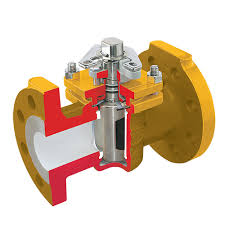Non-lubricated Plug Valve 2 inch 300 LB A216 WCB PTFE Sleeve API 599

The Application of Non-lubricated Plug Valve
Non-lubricated Plug Valves offer a reliable and low-maintenance solution for flow control applications where lubricated valves may not be suitable. Unlike lubricated plug valves, which require periodic lubrication, non-lubricated versions rely on the inherent properties of the materials used in their construction to provide a smooth and efficient operation. This makes them an ideal choice for environments where lubricants may be undesirable or difficult to maintain. Cameron, a leading manufacturer of industrial valves, offers a wide range of non-lubricated plug valve options to meet the diverse needs of customers across various industries, providing a cost-effective and reliable flow control solution.
What Are The Types Of Non-lubricated Plug Valve?
Resilient-Seated Non-lubricated Plug Valves:
These valves feature a resilient material, such as elastomer or polymer, lining the plug and body to provide a tight seal and smooth operation without the need for lubrication.
Metal-Seated Non-lubricated Plug Valves:
In this design, the plug and body are made of metal, relying on the inherent properties of the materials to create a reliable seal and minimize the need for lubrication.
Ceramic-Seated Non-lubricated Plug Valves:
Utilizing a ceramic seating surface, these valves provide exceptional wear resistance and durability, allowing for long-lasting performance without the requirement of regular lubrication.
What Is Non-lubricated Plug Valve?
Non-lubricated Plug Valves are a type of valve that relies on the inherent properties of the materials used in their construction to provide a tight seal and smooth operation, without the need for regular lubrication. Unlike lubricated plug valves, which require periodic application of lubricants, non-lubricated versions are designed to maintain their performance characteristics through the use of specialized materials, such as resilient elastomers, metals, or ceramics. This makes them a popular choice in applications where the use of lubricants may be undesirable or impractical, offering a low-maintenance and cost-effective solution for flow control. Cameron, a leading manufacturer of industrial valves, offers a wide range of non-lubricated plug valve options to meet the diverse needs of customers across various industries.
How to Select the Right Non-lubricated Plug Valve?
Service Conditions: Evaluate the operating pressures, temperatures, and fluid compatibility to ensure the valve materials and design can withstand the specific service requirements.
Flow Characteristics: Determine the desired flow capacity and valve size to match the system’s flow needs, as non-lubricated plug valves come in a range of sizes and port configurations.
Installation Requirements: Consider the valve’s physical dimensions, weight, and installation orientation to ensure it can be properly integrated into the piping system.
Maintenance Considerations: Select a non-lubricated plug valve that aligns with the expected maintenance schedule and accessibility of the installation location.
By carefully considering these factors, users can select the most appropriate non-lubricated plug valve from Cameron’s comprehensive product offerings to meet their specific flow control requirements.
Features of Non-lubricated Plug Valve
Durability:
Non-lubricated Plug Valves are designed with robust materials and construction, providing long-lasting performance and reliability even in demanding operating environments.
Low Maintenance:
Without the need for regular lubrication, non-lubricated plug valves significantly reduce maintenance requirements, lowering operational costs and downtime.
Versatility:
These valves can be configured with a variety of materials, sizes, and end connections, making them suitable for a wide range of applications.
Tight Sealing:
The specialized sealing mechanisms in non-lubricated plug valves ensure a tight, reliable seal, preventing leaks and maintaining flow control.
Cost-Effectiveness:
The simple design and reduced maintenance needs of non-lubricated plug valves make them a cost-effective solution for flow control applications.
Compact Design:
The compact and lightweight construction of non-lubricated plug valves allows for easy installation in space-constrained environments.
Advantages and Disadvantages of Non-lubricated Plug Valve
Advantages of Non-lubricated Plug Valves:
Reduced Maintenance:
Non-lubricated plug valves eliminate the need for regular lubrication, reducing maintenance costs and downtime.
Enhanced Reliability:
The robust construction and specialized sealing mechanisms of these valves provide long-lasting, reliable performance.
Versatility:
Non-lubricated plug valves can be configured with a variety of materials, sizes, and end connections to suit diverse applications.
Cost Savings:
The simplified design and low maintenance requirements make non-lubricated plug valves a cost-effective flow control solution.
Compact Design:
The compact and lightweight construction of these valves allows for easy installation in space-constrained environments.
Disadvantages of Non-lubricated Plug Valves:
Limited Temperature Range:
Depending on the materials used, non-lubricated plug valves may have a narrower operating temperature range compared to lubricated alternatives.
Potential for Leakage:
If the sealing surfaces become worn or damaged, non-lubricated plug valves may be more prone to leakage than lubricated versions.
Reduced Flow Capacity:
The design of non-lubricated plug valves may result in a slightly lower flow capacity compared to some lubricated valve types.
The Specifications of Non-lubricated Plug Valve
| Specification | Details |
|---|---|
| Type | Resilient-Seated Non-lubricated Plug Valve |
| Ball Material | Stainless Steel |
| Attachment Type | Threaded |
| Thread Standard | NPT |
| Thread Size | 1/2 inch |
| Body Material | Cast Iron |
| Safe for Use With | Water, Oil, Gas |
| Handle Type | Lever |
| Handle Material | Steel |
| Maximum Working Pressure (psi) | 200 |
| Maximum Working Pressure (bar) | 13.8 |
| Operating Pressure | 0-200 psi (0-13.8 bar) |